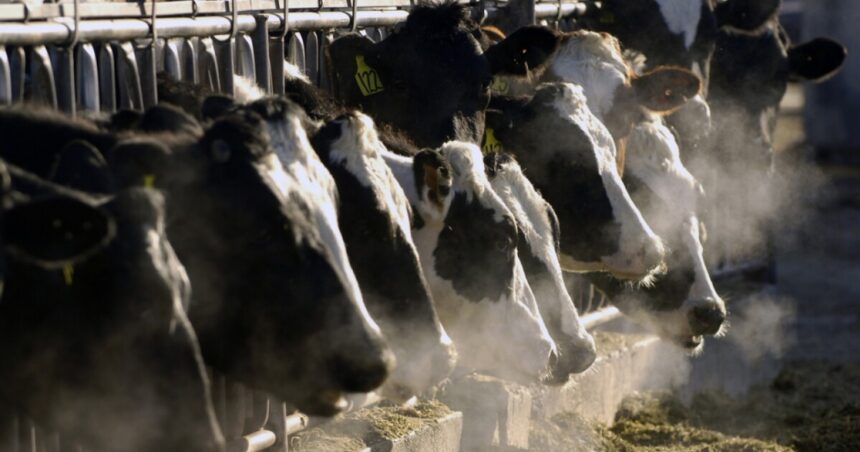A Colorado dairy worker has been diagnosed with bird flu, state health officials said Wednesday, becoming the fourth case tied to an unprecedented outbreak of highly pathogenic avian influenza among dairy cattle in the U.S.
Though this is the second confirmed infection of H5N1 in Colorado since 2022, Colorado health officials believe this is the first instance in which avian influenza was likely transmitted from a mammal to a human.
The dairy worker, who had direct exposure to dairy cattle infected with bird flu in northeast Colorado, had mild symptoms and reported only conjunctivitis (pink eye) to state health officials who tested him for influenza at the State Public Health Laboratory. Samples were then sent to the U.S. Centers for Disease Control and Prevention for additional testing, which confirmed the infection, according to a spokesperson with the Colorado Department of Public Health and Environment.
The state provided the dairy worker antiviral treatment per CDC guidance and has since recovered, the spokesperson said.
“The risk to most people remains low. Avian flu viruses are currently spreading among animals, but they are not adapted to spread from person to person,” said state epidemiologist Dr. Rachel Herlihy. “Right now, the most important thing to know is that people who have regular exposure to infected animals are at increased risk of infection and should take precautions when they have contact with sick animals.”
Related Story: US will pay Moderna $176 million to develop a bird flu pandemic vaccine
Colorado health officials are advising anyone who works with dairy cows that may have avian flu and who may start to feel sick to call the state health department. Officials said the department can help those potentially exposed with a flu test and medicine if needed.
“We continue to work closely with the Colorado Department of Agriculture, local public health agencies, and CDC as we monitor this virus to protect all Coloradans,” said Scott Bookman, the senior director of public health readiness and response at the CDPHE, in prepared remarks. “While it’s rare for people to become infected with avian flu viruses, direct exposure to infected animals increases that risk.”
So far, three other farm workers in the U.S. have contracted bird flu after coming into contact with sick cattle, according to the CDC, but none of the workers developed severe symptoms.
What’s my risk of catching bird flu?
Federal officials have stressed that the risk of catching bird flu for the general public is low, though risk depends on exposure, according to Herlihy, who said those in close contact with sick cattle or poultry are at greater risk of becoming infected with the virus.
No human-to-human transmission of bird flu has so far been detected, CDC officials added.
The nation’s top public health agency recommends that farm workers who come into contact with cattle suspected or confirmed to be infected with H5N1 wear disposable fluid-resistant coveralls, disposable gloves, boots or boot covers, vented safety goggles or a face shield, as well as an N95 respirator.
The general public should avoid contact with sick birds or other animals to reduce their chances of becoming infected with bird flu, Herlihy said. If you must handle sick or dead birds or animals, be sure to wear gloves, a high-quality mask such as a KN95 or N95 respirator, and eye protection. After handling the animal, double bag it and throw it away in your municipal trash can before thoroughly washing your hands.
Can I catch bird flu from drinking milk or eating meat?
While early research led by the Federal Drug Administration detected remnants of bird flu in retail milk, follow-up studies in which scientists tried to grow live virus from those grocery store samples did not yield any positive results.
Additional testing done by the FDA in mid-to-late April on nearly 300 dairy samples from 17 states also failed to detect any live, infectious virus, which they said reassured their previous statements that pasteurization inactivates H5N1 in milk.
Other milk-related products that undergo pasteurization, such as cheese, sour cream, yogurt and butter, are also safe to eat, health officials said.
Related Story: FDA shares research plans as it continues to monitor bird flu outbreak
FDA officials have said the likelihood that eggs will contain H5N1 is low “due to the safeguards in place, which include testing of flocks and federal inspection programs” that call for the disposal of eggs and meat from infected poultry. Proper egg storage and preparation “further reduce the risk,” they said.
Though the agency “does not know at this time if the HPAI H5N1 virus can be transmitted to humans through consumption of raw milk and products made from raw milk from infected cows,” scientists are advising people to avoid raw milk and dairy products made from raw milk, as it does not go through the process of pasteurization, which inactivates harmful viruses and bacteria.
The warning came about a month after research showed a large number of cats who were fed raw milk in Texas suffered brain damage and later died, though scientists said they could not completely rule out if eating dead birds was how the cats came into contact with the virus in the first place.
In early June, the FDA sent a letter calling on state and tribal public health officials around the nation to curb the sale of raw milk and other raw milk products that may contain high levels of the virus.
This story was originally published by Óscar Contreras at Scripps News Denver.





